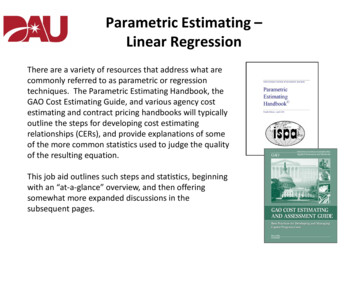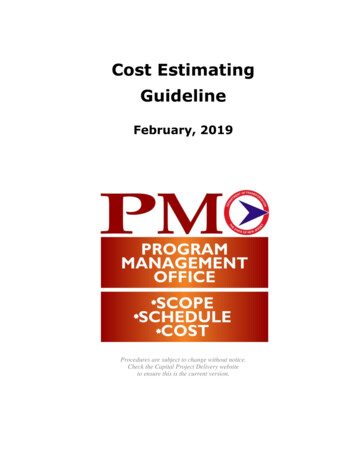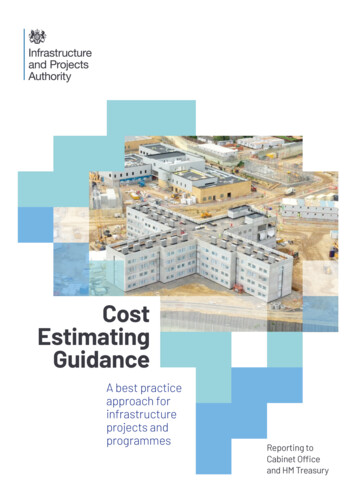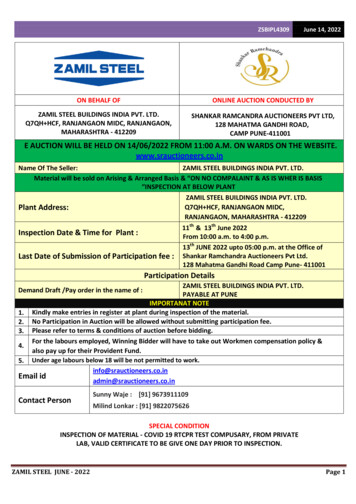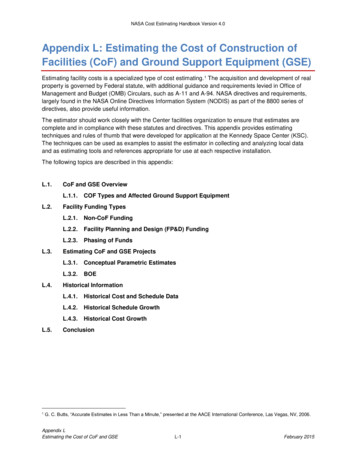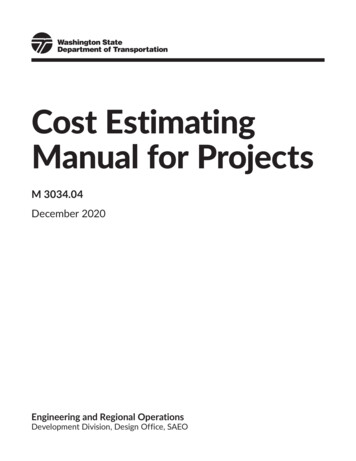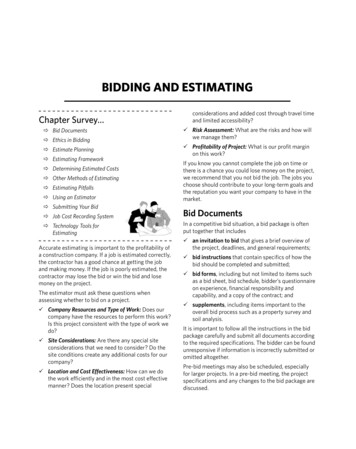
Transcription
Bidding and EstimatingChapter Survey ÖÖ Bid DocumentsÖÖ Ethics in BiddingÖÖ Estimate PlanningÖÖ Estimating FrameworkÖÖ Determining Estimated CostsÖÖ Other Methods of EstimatingÖÖ Estimating PitfallsÖÖ Using an EstimatorÖÖ Submitting Your Bidconsiderations and added cost through travel timeand limited accessibility?99Risk Assessment: What are the risks and how willwe manage them?99Profitability of Project: What is our profit marginon this work?If you know you cannot complete the job on time orthere is a chance you could lose money on the project,we recommend that you not bid the job. The jobs youchoose should contribute to your long-term goals andthe reputation you want your company to have in themarket.ÖÖ Job Cost Recording SystemBid DocumentsÖÖ Technology Tools forEstimatingIn a competitive bid situation, a bid package is oftenput together that includesAccurate estimating is important to the profitability ofa construction company. If a job is estimated correctly,the contractor has a good chance at getting the joband making money. If the job is poorly estimated, thecontractor may lose the bid or win the bid and losemoney on the project.The estimator must ask these questions whenassessing whether to bid on a project.99Company Resources and Type of Work: Does ourcompany have the resources to perform this work?Is this project consistent with the type of work wedo?99Site Considerations: Are there any special siteconsiderations that we need to consider? Do thesite conditions create any additional costs for ourcompany?99Location and Cost Effectiveness: How can we dothe work efficiently and in the most cost effectivemanner? Does the location present specialNASCLA LA 12E ch07b.indd 199an invitation to bid that gives a brief overview ofthe project, deadlines, and general requirements;99bid instructions that contain specifics of how thebid should be completed and submitted;99bid forms, including but not limited to items suchas a bid sheet, bid schedule, bidder’s questionnaireon experience, financial responsibility andcapability, and a copy of the contract; and99supplements, including items important to theoverall bid process such as a property survey andsoil analysis.It is important to follow all the instructions in the bidpackage carefully and submit all documents accordingto the required specifications. The bidder can be foundunresponsive if information is incorrectly submitted oromitted altogether.Pre-bid meetings may also be scheduled, especiallyfor larger projects. In a pre-bid meeting, the projectspecifications and any changes to the bid package arediscussed.6/5/15 2:33 PM
Bidding Guidelines Under Louisiana LawIn the State of Louisiana, a contractor’s licenseis required prior to bidding on commercial projects of 50,000 or more; electrical, mechanical, or plumbing projects exceeding 10,000;residential projects of more than 75,000;home improvement projects exceeding 7,500(home improvement projects exceeding 75,000 are considered residential projects);mold remediation projects of 1 or more; andhazardous materials projects (including asbestos, lead removal and abatement, undergroundstorage tank installation and removal, andhazardous waste treatment or removal) of 1or more.All architects, engineers, and awarding authorities must state in the bid specifications therequirement that a contractor hold an activelicense and show the license number on thebid envelope.If the bid does not contain the contractor’scertification and show the contractor’s licensenumber on the bid envelope, the bid is automatically rejected.If changes are made to a bid package before it is due,an addendum is issued. The addendum becomespart of the bid documents and, ultimately, part of thecontract when awarded. It is important to carefullyreview all addenda to evaluate the impact on your bid.Changes in plans and specifications may affect yourbid pricing or even your decision to bid at all.Carefully evaluate whether bidding on a project isthe right decision for your company.Ethics in BiddingGood ethical conduct is necessary to maintain theintegrity of the bidding process. The situations listedbelow are not only a poor way to do business, butsome state statutes forbid these practices on publicprojects.99Bid ShoppingBid shopping occurs when the general contractorapproaches subcontractors other than those whohave submitted bids to seek a lower offer thanNASCLA LA 12E ch07b.indd 2what was quoted in original bids. In this situation,the general contractor reveals the original bidssubmitted and tries to reduce the price.99Bid PeddlingBid peddling occurs when the subcontractorapproaches the general contractor after the projectwas awarded with the intent of lowering theoriginal price submitted on bid day.99Bid RiggingBid rigging is a form of collusion where contractorscoordinate their bids to fix the award outcome of aproject.Estimate PlanningOnce you have determined that you want to submita bid, you must prepare your estimate. An estimateis the sum of the costs to complete the project, plusyour added overhead and profit margin. Before youstart putting numbers down on paper, you shouldunderstand all the factors that impact the cost ofthe job. A good estimate will fall within 1 percent to2 percent of actual construction costs.Project DocumentsA complete set of project documents is required toprepare an accurate cost estimate. These documentsinclude the following:99Construction or architecturaldrawings that show aschematic diagram of the job.The drawings may illustratemany different views orelevations of the job.99Specifications are details thatdetermine the type of materials or methods to beused in construction. If there is a conflict betweenthe specifications and applicable codes, you mustfollow the stricter of the two. The codes are theminimum requirements by law. You must alwaysmeet or exceed the applicable codes.99The contract is the agreement between you andyour customer to complete the specified work.The conditions outlining the obligations of eachparty, such as the owner and contractor, areincluded in the contract. If your bid is accepted, theconstruction drawings and specifications becomepart of the contract package. Contracts are coveredin more detail in Chapter 8.6/5/15 2:33 PM
99Bonds may be required as part of the bid submittal(discussed in Chapter 4). Bonds commonlyrequired are bid and performance bonds.You should carefully review these documents tounderstand the project and the expectations of thecustomer.Site VisitThere may be specifics about the site that influencethe cost estimate. These details cannot always bedetermined from the construction documents. It isimportant that you go to the actual site and look at anyfactors that may impact the project. Soil type, grading,vehicle access, and availability to electricity and waterare some of the variables that could affect the cost ofthe project. You want to anticipate as many of theseproblems as you can before beginning work.During this time, you should consider theenvironmental aspects of the project. If you need toobtain environmental permits, this process will affectyour estimated costs.Louisiana Pollutant Discharge EliminationSystem (LPDES) PermitsIt is important to note that Louisiana PollutantDischarge Elimination System (LPDES) permitrequirements may have a significant impacton your project. Projects that involve thedischarge of pollutants from any point sourceinto waters of the State of Louisiana require anLPDES discharge permit. As defined under LAC33:IX.2313, a point source is any discernible,confined, and discrete conveyance, includingbut not limited to any pipe, ditch, channel, tunnel, conduit, well, discrete fissure, container,rolling stock, concentrated animal feedingoperation, landfill leachate collection system,vessel, or other floating craft from which pollutants are or may be discharged. Additionalinformation on LPDES permits is covered inChapter 12, Jobsite Safety and EnvironmentalFactors.Your project may also require special equipment andprocesses that should be factored into your estimate.Chapter 12, Jobsite Safety and Environmental Factors,discusses environmental impacts in more depth.NASCLA LA 12E ch07b.indd 3Estimating FrameworkEstimating should be a systematicprocess. Approaching the estimate inan organized way will help you avoiderrors or omissions. Taking the extra time to constructa framework for the estimate will increase youraccuracy.Your estimating framework essentially lists the processfor completing the job. This can be accomplished by99defining the phases of the project; and99listing each task and materials needed for eachphase.Once your framework is established, you can enter thetime and cost for each task. If you are awarded the job,you can easily convert your estimating framework intoyour job schedule.Define the PhasesThe first thing you need to consider when you buildyour estimate is the phases of the project that you areworking on. For example, you might list the phases aspreconstruction, construction, and post-construction.The order of tasks will drive your scheduling process.List Each Task and Materials NeededOnce you list the phases of the project, you need todevelop a list of tasks and materials for each phase.Be very specific in this step. If you omit an item or addan unnecessary item, your estimate will be inaccurate.The task and material list should also include labortime needed and material amounts. By identifyingthese items early in the process, you may determinethe need for items such as overtime to meet certainproject deadlines and temporary storage. All of theseitems play a part in the cost estimate.Estimating ChecklistThe Construction Specifications Institute publishesa classification system called MasterFormat. Thissystem includes numbers and job tasks groupedby major construction activities. This is a helpfultool when setting up your estimating framework toensure that you have accounted for all aspects ofmaterials and labor. After you become familiar withthe estimating process, you may develop your ownestimating checklist customized for your needs.6/5/15 2:33 PM
Determining Estimated CostsQuantity Take-off MethodOne accurate method of estimating is the quantitytake-off method. Using this method, you individuallyestimate units of materials and labor for each task youlisted in your estimating framework.Another helpful tool when determining labor cost isyour historical cost data. Determining your final laborcost from past projects will help you put together moreaccurate estimates for future jobs. Developing acost-tracking system is discussed later in this chapter.Add Labor Burden99project overhead costs,As an employer, you incur costssuch as employmenttaxes and insurance. Theseobligations add approximately30 percent to your labor cost. Thisadditional amount is referred to aslabor burden.99project equipment,Labor burden includes items such as99contingencies,99Medicare and social security (discussed inChapter 15),After estimating materials and labor, the followingitems are added:99subcontractor fees,99labor burden,99allowances,99company overhead, and99profit.By going through the items individually, you can adjustyour estimate to accommodate the unique aspects ofthe project you may have uncovered when reviewingthe construction documents or during your site survey.Determine Labor Cost for Each TaskUsing your estimating framework, you canbegin to enter your labor cost. Informationfrom previous jobs can help you determine accuratejob costs. There are also published costs availablethrough books such as the RSMeans cost data series,but this is no substitute for your knowledge of theindustry. Your experience with your local labor marketand wages should be factored into your estimatedcosts.For each labor item on your estimating framework list,use the following formula to determine the labor cost.Required Labor Hours per Task x Labor Rate LaborCost per TaskThe required labor hours can varybased on several different factors,such as employee skill level, size ofcrew, and weather conditions. Thesefactors must be taken into accountwhen determining the required labor hours. Hoursspent planning and scheduling must also be figuredinto the labor cost equation.NASCLA LA 12E ch07b.indd 499federal unemployment insurance (discussed inChapter 15),99workers’ compensation,99liability insurance,99state unemployment insurance, and99company benefits (such as medical insurance,vacations, etc.).Labor burden must be factored into your total laborcost.Determine Materials CostJust as you plugged laborcost into your estimatingframework, you can do the same withmaterials cost. For each material itemlisted on your estimating framework,you need to obtain a cost.Your suppliers can provide you with the materialsprice per unit or a lump sum. The cost of materials canfluctuate according to the availability of raw materialsand demand, so it is important to keep currentcost data. In addition to tracking wage, earnings,employment, and benefit statistics, the Bureau ofLabor Statistics (www.bls.gov) tracks the prices ofmajor groups of construction materials as part ofits Producer Price Index (PPI) program. Periodicallyreviewing this resource can help you understandpotential increases and decreases in materials cost.You may receive the materials cost as a unit cost. Ifnecessary, use the following formula to determine the6/5/15 2:33 PM
total material cost per unit for each of the materialscategories on your take-off sheet.Price per Unit x Number of Units Needed Total Material Unit CostTo make sure you receive the best price, obtain at leastthree bids from suppliers. You should also add a smallcontingency for waste. Depending on the type ofmaterial and the job specifications, your wastecontingency will vary.Determine Project Equipment CostEquipment needed to complete the job isfigured as a direct cost of the project andadded to your estimate.For example, if you need a crane to set an air handlingunit on top of a building as part of a HVAC project, it isconsidered a direct cost.Small tools and pickup trucks are considered anindirect cost and not part of project equipment. Theseindirect costs are figured into project overhead.Figuring the direct cost of equipment differs dependingif you rent or own the equipment.Owned Equipment: To estimate owned equipment,you must arrive at a unit cost for the equipment. Tocalculate unit cost, consider the following factors:99actual value of equipment factoring in its age andamount of depreciation from the original purchaseprice;99maintenance and operating costs;99taxes and fees;99labor to operate equipment, including any trainingor licensing costs; and99insurance.Unit cost is calculated by estimating the number ofhours you will use the equipment per year and dividingthis number by the total yearly cost of the equipmentcalculated by considering the operational factors.For example, if you figure the total cost of theequipment for the year is 30,000 and you plan to usethe equipment for a total of 1,000 hours, your unit costto operate the equipment is 30 an hour.If you estimate using the equipment for 40 hours on aproject, your estimated project equipment cost for thatproject is 1,200.NASCLA LA 12E ch07b.indd 5Rental Equipment: The following items are consideredwhen figuring the cost of rental equipment:99equipment rental rate;99labor cost to pick up and return equipment ordelivery fees;99labor cost to operate equipment; and99other costs associated with operating theequipment (e.g., cost of fuel).Subcontracting: You may decide that neither optionis cost effective or feasible and subcontract thework. In this case, this line item would appear undersubcontractor fees.Rent, Lease, or Buy? Construction equipment is vitalto the completion of construction projects. Equipmentcan range from cranes to computers. The decision torent, lease, or purchase this equipment is a challengingone, and there are many considerations to each option.Leasing is a long-term rental agreement thatprovides the benefits of using the equipment withoutpurchasing. Lease payments are made to the ownerof the equipment in exchange for the use of theequipment. At the end of the lease term, the ownertakes possession of the equipment.Leasing equipment has many advantages. One ofthe biggest is the ability to use the equipment witha limited capital expenditure. Other advantagescompared to purchasing include99no down payment;99duration of payments over a longer period makingthem lower;99lease payments (as defined by the IRS) aredeductible as operating expenses; and99obsolete equipment is returned to the owner atend of the lease.Equipment ownership allows you to take advantage ofcertain tax benefits and in the long run usually costsare less than leasing. Leases are long-term contractualagreements that generally cannot be cancelled. If youno longer need the equipment, you must still makepayments for the full term of the lease.Purchasing equipment is advantageous whenthe equipment has a long and useful life and willnot become obsolete in the short-term. You gainownership of the equipment after the purchase ismade but you should consider how the equipment will6/5/15 2:33 PM
hold value over a long-term period. For this reason,salvage value is a benefit to purchasing equipment.Renting equipment may be an alternative topurchasing or leasing. Although renting equipmentis usually the costliest, it is the best option in certaincircumstances. These include99short-term, specialized projects;99replacement for equipment being repaired;99equipment with high maintenance costs; and99jobs that require transportation and storage todistant locations.The decision to rent, purchase, or lease is one thatshould be analyzed carefully to provide the mostcost-effective solution for your company.Add Subcontractor FeesSubcontractors will be a consideration if youneed to outsource work that your companydoes not have the resources to complete. Chapter 13covers hiring and working with subcontractors. Youshould get at least three bids from subcontractors, soyou have a good measure of comparison. Carefullyevaluate subcontractors to determine that they havethe proper qualifications, licensure, and insurancecoverage. Subcontractor fees must be added to theestimate that you give your customer.Add AllowancesThere may be items that are not specified inthe project plans, such as finish materials(carpeting, fixtures, lighting, etc.). For these items, youcan specify an allowance in your estimate. This is theowner’s budget for these items. If the owner’s choicesexceed or fall short of the allowance amount, thecontract should clearly address who is responsible forthe difference. Typically, a change order is createdstating the amount under or over what is stated in thecontract. Change orders are discussed in Chapter 8.Add ContingenciesA contingency percentage is sometimesadded to an estimate to protect thecontractor if an unanticipated problem or conditionarises during the course of the project. Contingencymarkups are generally based on the risk level of theproject.NASCLA LA 12E ch07b.indd 6For example, a low risk project might have a 2 percentcontingency markup, but a project that has moreunknown factors would have a higher markup.Add Project OverheadProject overhead costs are items that arenecessary to complete the project but arenot directly associated with labor and materials. Thesecosts typically account for 5 percent to 10 percent ofthe total bid, but these costs should be itemized asmuch as possible to achieve the most accurate result.Examples of project overhead costs include99bonds,99temporary storage,99temporary office,99security guard,99utilities,99dumpsters, and99portable toilets.Project overhead differs from company overhead.Company overhead cannot be directly linked with aproject.Add Company OverheadCompany overhead is the cost of doingbusiness. These expenses are necessary tokeeping the operation running. Examples of theseexpenses are99office rent,99accounting fees,99taxes,99telephone,99legal fees, and99administrative labor.Calculating an Overhead PercentageUsing historical information from the past year is thebest way to predict overhead for the following year.Overhead percentages generally average between5 percent and 20 percent, so it is best to calculate theoverhead rates specific to your company.Company Overhead: To arrive at a company overheadpercentage, you can make the following calculations.6/5/15 2:33 PM
99Add up all of your overhead costs from theprevious year. These numbers may be foundon your income statement as part of youradministrative expenses.percentage is divided into the direct costs of theproject, just like the overhead costs in the previousexample. If you estimated correctly, you will achieveyour internal profit margin goals.99Divide your overhead costs by your revenues(found on your income statement) to arrive at youroverhead percentage.The standard industry markup is 15 percent, but youshould consider the market and competition. Youmust be careful to keep your estimate in line withyour competition and understand how much yourcustomers are willing to pay for your work.Project Overhead: Project overhead is a similarcalculation.99Add up all of your project overhead costs from theprevious year.99Divide your project overhead costs by yourrevenues (found on your income statement) toarrive at your overhead percentage.Adding Overhead to the Bid: You must add theseoverhead percentages to your estimate to coveroverhead costs.For example, let’s say you calculated the direct costsfor your bid at 100,000, your project overhead at9 percent, and company overhead percentage at11 percent. Your direct costs are then 80 percent ofyour total bid price. Since overhead is a percentage ofrevenue, you should divide the direct costs of your bidby 80 percent (.80).Here is what the calculation should look like: 100,000 .80 125,000After adding in overhead, the bid price with directcosts and overhead is 125,000.Add Markup and Determine ProfitMarginConsiderations for properly pricing a jobinclude99cost estimate,99customer needs and expectations,99local market and competition, and99expected profit margin.Determining the right pricing based on these factorsis important to maximizing your profit and satisfyingyour customers.Cost-based pricing is one of the most common waysto price a bid. Essentially, the cost of the project isdetermined through the cost estimate and an overheadpercentage, plus a markup percentage. The markupNASCLA LA 12E ch07b.indd 7In your estimate, markup is applied to the directcosts of the project, such as labor, material, projectequipment, project overhead, and subcontractors.If your markup is too low, you may not cover yourproject costs, causing you to break even, or lose moneyon the job. To get the work, you may decide to bidlow by lowering your profit markup and make it upon future projects, but this should not be a commonpractice. You will eventually go out of business if aninsufficient amount of profit is achieved over time.On the flip side, if your markup is too high, you may bidyourself out of jobs. Typically, the higher the markup,the fewer jobs you receive. The lower the markup, themore jobs you receive. You must estimate and chooseyour markup carefully to ensure a steady flow of jobsand profits for your company.Attention to detail is important to preparing anaccurate estimate.Other Methods of EstimatingQuantity take-off is generally the most accurate way toestimate, but there are other estimating methods youcan use.99A conceptual estimate is generally prepared by thearchitect using cost models from previous projects.The contractor may arrive at a much different costbecause of the project’s unique characteristics.99Using the square-foot method of estimating, theproject cost is a calculation of the square footageof the project multiplied by a unit cost. This is aquick way to arrive at an estimated cost, but thismethod does not account for project specifics thataffect cost. Another variation of this method isputting together an estimate using cubic feet of theproject multiplied by a unit cost.6/5/15 2:33 PM
99The unit price method of estimating bundles allcost factors such as labor, materials, equipment,and subcontractors to come up with a unit pricefor the entire task. For example, let’s say you areplacing and finishing a 2,000-square-foot concreteslab and you determined that your unit price is 2.00 per square foot for this task. The total unitprice is 4,000.Estimating PitfallsAccurate estimating is a vitalfunction for construction businessesand can make the difference betweengetting the right jobs and making a profit on a job.There are pitfalls that are detrimental to the estimatingfunction that you want to avoid.Preliminary EstimatesYour customers may be eager to determine whattheir project will cost and will ask for an estimate onthe spot. Quoting a price before you have a chance tomake accurate calculations is a risky practice. If youquote a price too high, it is possible that you couldlose the bid. If you quote a price too low, the potentialcustomer may be disappointed and feel you weredishonest in your initial contact.Inaccurate EstimatesInaccuracies occur when you make errors andomissions in your estimate. To avoid inaccuracies, youshould always check your estimates. Errors to look for:99Mathematical errors: Always check your workand if possible, have someone else check themathematical accuracy of the estimate.99Omissions in labor or materials: Be as thorough aspossible when setting up the framework for yourestimate. The use of a standard format, such asMasterFormat, will help you avoid this mistake.99Non-standard abbreviations: Non-standardabbreviations may be interpreted as a differentmeasurement or material. Spell out the actualword rather than inventing an abbreviation that isunclear or vague.NASCLA LA 12E ch07b.indd 899Units of measure: Define linear, square, and cubicmeasure accurately. The difference between thesemeasures can make a drastic difference in cost.The more accurately you prepare your estimates, thebetter chance you have to make your projected profit.Accurate estimates help you get the right jobsand make a profit.Using an EstimatorEstimators develop the cost information businessowners or managers need to bid for a contract. Smallbusiness owners or managers may perform thisfunction without the use of a professional estimator.Large companies or a large project may need to use anestimator.Estimators follow the same estimating process:performing the quantity take-off, analyzingsubcontractor bids, determining equipment needs andsequence of operations, analyzing physical constraintsat the site and contingencies, and determiningallowances and overhead costs. The estimator mayalso have a say in setting the profit for the projectand the terms and conditions of the contract. Theestimator’s job is solely to perform the estimatingfunction and, if used, the estimator is an importantmember of the project team.Submitting Your BidOnce your estimate is complete and you are ready tosubmit your bid, you must make sure to follow all ofthe instructions in the bid package. These instructionsinclude submitting all of the required documents andthe exact information requested by the bid submissiondeadline. Even though you may have a templateput together for the estimating process, you mayneed to customize your bid so as to respond to thebid specifications. Once your bid is submitted, it isreviewed by the owner. Bid review is generally a 30- to90-day process. You are notified of the acceptanceor rejection of your bid after this review process iscomplete.6/5/15 2:33 PM
Job Cost Recording SystemA job cost recording system provides many benefits tothe estimating and project management process.99Current projects are monitored more closely with acost tracking system. Cost overruns are identifiedand corrective action is taken sooner.99Information from a job cost recording system helpswith future estimates by creating more accurateunit costs.99Many analytical reports can be generated fromcost data to review performance by project,activity, year, etc. Using this data can help youmake more strategic decisions.There are many ways to set up a job cost recordingsystem, but to ensure accuracy, it must remainconsistent for all projects.The first step is to develop a cost code system. A costcode system includes the following components.99Project Number: A project numbering system couldbe as simple as starting with the number one (1)and consecutively numbering subsequent projects.A more complex project numbering system mightalso include a code for the type of project and theyear it was started. For example, let’s say you areworking on a remodel project (R) that started in2006 (06) and was the first (01) project of theyear. Your project number could be R-06-01.99Activity Classification Code: You may want todevelop your own system or use a classificationsystem such as the CSI MasterFormat. Forexample, for a finish carpentry job you could useMasterFormat number 06200. If you use the sameclassifications on your estimate, it will be easier tocompare estimated to actual costs.99Distribution Code: These are items such asmaterial, labor, equipment, and project overhead.For example, coding might be as simple as oneletter abbreviations:Material MLabor LEquipment EProject Overhead PThis code can be placed behind the activityclassification code. For example, the labor forfinish carpentry could be classified as 06200L andmaterials as 06200M.NASCLA LA 12E ch07b.indd 9Once your system is set up, you can begin entering thecost data. Materials, equipment, and project overheadcosts can be gathered from purchase orders, receipts,and invoices. Labor costs can be taken from timecards.It is important that employees fill out timecardscompletely and with enough detail so you canaccurately record la
Bidding Guidelines Under Louisiana Law In the State of Louisiana, a contractor's license is required prior to bidding on commercial proj-ects of 50,000 or more; electrical, mechani-cal, or plumbing projects exceeding 10,000; residential projects of more than 75,000; home improvement projects exceeding 7,500

